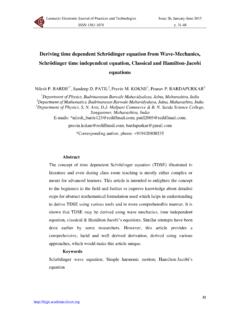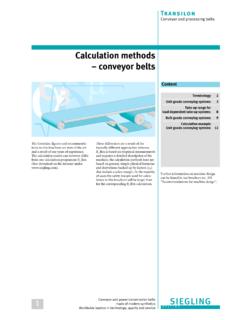Transcription of Digital Phase Locked Loop Induction Motor Speed …
1 Leonardo Electronic Journal of Practices and Technologies Issue 20, January-June 2012. ISSN 1583-1078 p. 159-174. Digital Phase Locked Loop Induction Motor Speed Controller: Design and Experiments Mouna BEN HAMED* and Lassaad SBITA. National Engineering School of Gab s - ENIG, Zrig 6029 Gab s- Tunisia E-mail(s): *. Corresponding author: Phone: +216 95 851 313; Fax: +216 75 392 190. Abstract Phase Locked loop (PLL) is a technique which has contributed significantly toward the technology advancement in communication and Motor servo control systems.
2 Inventions in PLL schemes combining with novel integrated circuit have made PLL devices important system components. The development of better modular PLL integrated circuit is continuing. As a result, it is expected that it will contribute to improvement in performance and reliability for communication and servo control systems. In this paper, the study of the Speed control of Induction Motor (IM) drives using Digital Phase Locked loop (DPLL) is discussed. A novel scalar law which compensates the slip frequency loop calculation is proposed. The overall investigated system is tested using a 1Kw IM.
3 Different Speed trajectories are considered covering the realistic operating range. The PLL IM drives controller is implemented all around the most popular integrated circuits 4046 PLL. Experimental results are presented to show the performance of the investigated control system. Keywords Phase Locked loop; Induction Motor ; Scalar law; Speed control; Slip compensation. 159. Digital Phase Locked Loop Induction Motor Speed Controller: Design and Experiments Mouna BEN HAMED and Lassaad SBITA. Introduction Three Phase IMs are the most widely used electrical motors due to their ruggedness, robustness and low cost [1, 2].
4 It can be operated directly from the main. However, variable Speed and often better energy efficiency are achieved by means of a frequency converter between the main and the Motor . A typical frequency converter consists of a rectifier, a voltage stiff dc link and a pulse width modulated (PWM) inverter. The inverter is controlled with a Digital signal processor (DSP). A simple way to control the IM is to adjust the magnitude of the stator voltage proportionally to its frequency. This open loop method known as the scalar control or constant voltage per hertz law is still used for low cost frequency converter due to its important advantages [2, 3]; a Speed sensor isn't needed.
5 The knowledge of the Motor parameters is not necessary either implying that the strategy is robust. However, the dynamic performance and the Speed accuracy are poor [4]. To improve the accuracy of the rotor Speed in control strategy, the main idea is based on the slip frequency compensation [5]. It can be divided into two classes. The first is based on the addition of frequency compensation in open loop control strategy. While, for the second, the accuracy of the rotor Speed is improved with slip regulation in closed loop Speed drives. Improved techniques using the Phase component of the stator current and a compensation proportional to a slip signal have been proposed [6].
6 Vector compensation was proposed in [7], but it requires both voltage and current sensors and accurate knowledge of machine inductances. More recently, a scalar control scheme was proposed [8]. In this scheme, the flux magnitude is derived from the current estimation. In [9], the slip compensation was based on a linear torque- Speed assumption which led to large steady-state errors in Speed for high load torques. A linearized frequency compensation control based on an ideal IM was proposed in [10]. The frequency compensation is based on an estimation of the air gap power and a nonlinear relationship between slip frequency and air gap power is carried out in [5].
7 Since these methods are based on slip computation loop, the computation time increases which decrease the performances of the overall control system. To improve these performances of the open loop scalar IM drives, a feedback Speed control signal is added. Conventional Speed closed loop control with slip frequency regulation to improve the Speed accuracy in open loop control strategy is based on the well-known Motor frequencies equation [11]. Here, the Motor Speed is compared to the target one and the error 160. Leonardo Electronic Journal of Practices and Technologies Issue 20, January-June 2012.
8 ISSN 1583-1078 p. 159-174. generates the slip frequency command through a controller and a limiter. The slip frequency is added to the rotor Speed to generate the frequency and voltage commands as shown in Figure. 1. Figure 1. Bloc diagram of conventional scalar strategy in IM. The high performance of the Speed regulation depends on the performance of the Speed controller. Researchers have used various types of closed loop controllers for the IM. rotor Speed . Among these controllers, the proportional integral derivative controllers are widely used in the outer Speed loop [12, 13].
9 However, the use of this type of controller is more sensitive to parameter variation [14, 15]. To overcome this problem, adaptive [16, 17]. and robust [18-20] control laws were used. The adaptive control imposes a very computation burden while H robust control requires the knowledge of the disturbances boundaries [18]. The sliding mode control is also used in the Speed loop [21]. The high chattering and switching frequency limit the use of this controller [22, 23]. Recently, Speed controllers based on artificial intelligence techniques such as fuzzy logic and neural network based controllers have been proposed [24, 25].
10 Since these approaches do not require the knowledge of a mathematical machine model, the algorithm would remain robust despite of parameter deviations and noise measurement [26, 27]. However, the computation expenses and the requirement of expert knowledge for the system setup have seriously restricted their applications in practice. In [28], an internal model controller (IMC) is developed for the feedback of the scalar controlled IM. This IMC controller has the advantage of robustness, ease of design and good responses. In some applications, a precise Speed is required.







